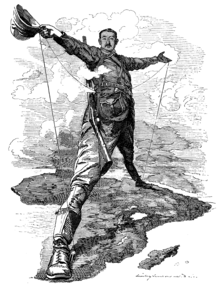The Rhodes Colossus
The Rhodes Colossus , in full title The Rhodes Colossus Striding from Cape Town to Cairo , is a caricature by Edward Linley Sambourne that appeared in the satirical magazine Punch on December 10, 1892 . It is one of the most famous political caricatures of the 19th century and is often depicted in the discourse surrounding the race for Africa . The caricature was reprinted several times after it was published and has since been featured in many history books related to British imperialism .
The caricature was created in the context of the fact that, after the Congo Conference in 1884/1885 , Great Britain was able to bring numerous colonies from Egypt in the north to the Cape Colony in the south under its rule. The Rhodes Colossus shows the British colonialist Cecil Rhodes as a giant who has his right foot in what will later be South Africa and his left foot in Egypt, connecting both sides of the African continent with cables. The cartoon was a satirical commentary on Rhodes' plans to move cables for electrical telegraphs from Cape Town to Cairo .
The name of the caricature and the illustration allude to the Colossus of Rhodes , whereby the same name between Rhodes and the Greek island of Rhodes is a play on words . In the original publication, the newspaper publisher published a satirical poem in verse about Rhodes' plans in addition to the caricature. Linley Sambourne responded to an article that appeared on November 30, 1892 in The Times . With the caricature, he wanted to brand the arrogance of the British colonialists who, as part of the Cape-Cairo plan, also wanted to build a rail link from the south to the north of Africa. The telegraph is seen as a symbol for the spread of colonial power, as it was primarily intended to facilitate communication between the British colonial rulers in different parts of Africa and thus to further expand the supremacy over the indigenous population.
Individual evidence
- ↑ Richard Scully: Constructing the Colossus: the Origins of Linley Sambourne's Greatest Punch Cartoon . In: International Journal of Comic Art . tape 14 , 2, autumn 2012, p. 120-142 .
- ↑ a b Ronald Wenzlhuemer: Connecting the Nineteenth-Century World: The Telegraph and Globalization . Cambridge University Press, 2013, pp. 77 ff .
